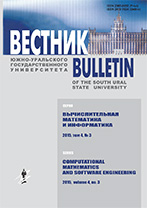|
Using multivariate quantile function for peptide-protein docking
S. V. Poluyana, N. M. Ershovb
a Dubna State University ( Universitetskaya 19, Dubna, 141982 Russia)
b 2Lomonosov Moscow State Universisty (GSP-1, Leninskie Gory 1, Moscow, 119991 Russia)
Abstract:
The paper presents an exploration of using evolutionary optimization algorithms in protein-peptide docking. The main assumptions that reduce docking to the continuous global optimization problem are described. Some special features of the given problem and the difficulties of using evolutionary algorithms are discussed. The paper provides a way of using evolutionary optimization algorithms based on using empirical quantile function. The multivariate quantile function structure is defined recursively using univariate quantile transform. The grid-based approach of using quantile function is presented. The disadvantages of this approach are indicated. The deterministic sampling algorithm is proposed. The used scheme of parallel sampling and the resulting speed-up are described. The GPU-accelerated approach for quantile function evaluation is presented. This paper provides multiple GPU-based ways which use a sample in explicit form. Their speed-up depending on sample size is shown. The paper presents the results of docking using an evolutionary algorithm and its quantile-function-based modification. The comparison with the relevant docking method within a particular force-field is made. The results of the experiments are analyzed.
Keywords:
global optimization, evolutionary algorithms, empirical quantile function, docking.
Received: 03.11.2018
Citation:
S. V. Poluyan, N. M. Ershov, “Using multivariate quantile function for peptide-protein docking”, Vestn. YuUrGU. Ser. Vych. Matem. Inform., 8:2 (2019), 63–75
Linking options:
https://www.mathnet.ru/eng/vyurv212 https://www.mathnet.ru/eng/vyurv/v8/i2/p63
|

| Statistics & downloads: |
| Abstract page: | 144 | | Full-text PDF : | 53 | | References: | 12 |
|




 Contact us:
Contact us: Terms of Use
Terms of Use
 Registration to the website
Registration to the website Logotypes
Logotypes








 Citation in format
Citation in format 